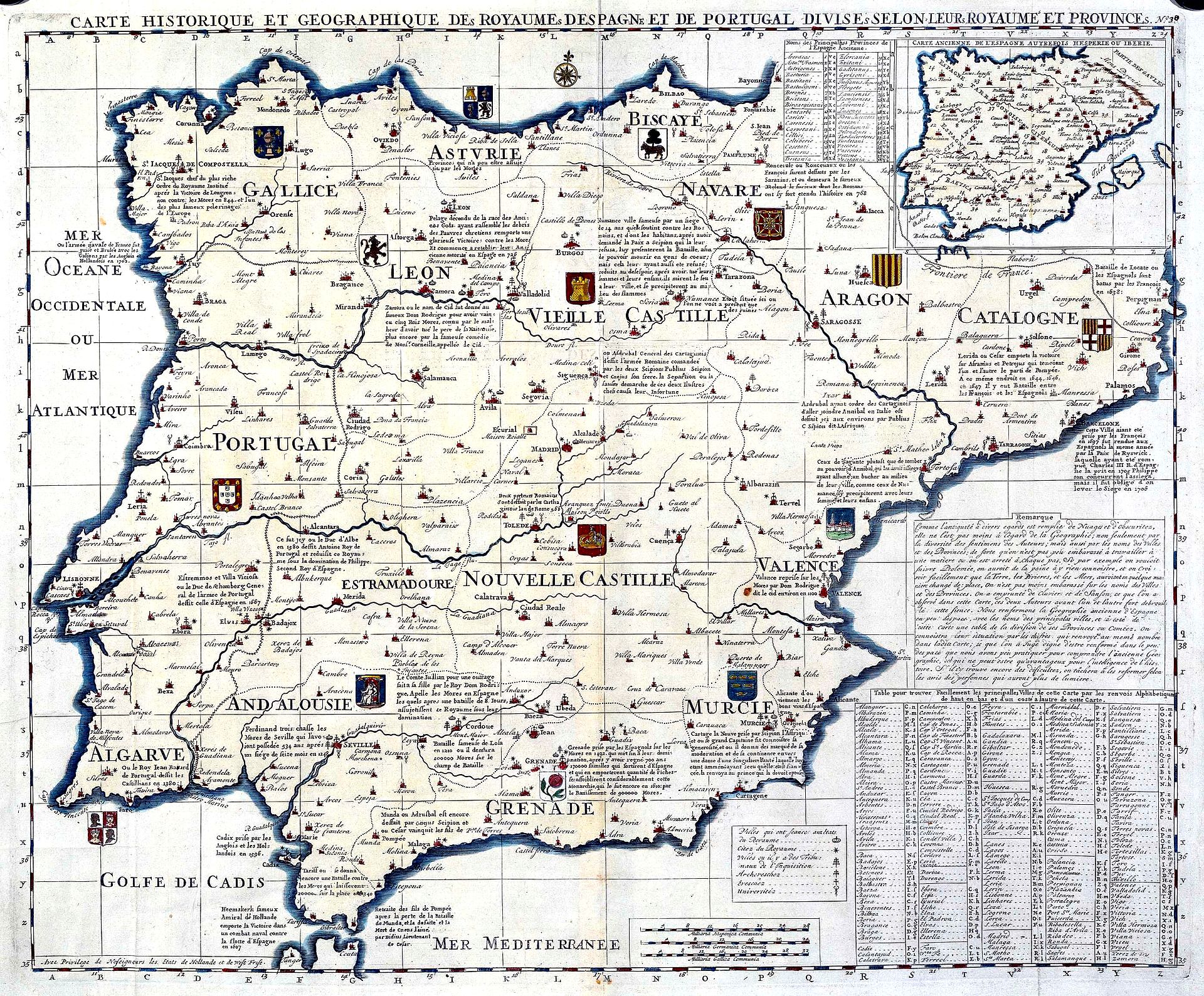
スペインの歴史01:先史時代からアルアンダルスからレコンキスタまで
History of Spain 01: from
Prehistory to Islamic al-Andalus and the Christian Reconquest (8th–15th
centuries)
☆ スペインの長い歴史は次の4つの位相にわけるのが一般的だ。
(1) スペインの歴史は、イベリア半島地中海沿岸の先ローマ民族とギリシャ人およびフェニキア人の接触にまで遡る。古典古代の間、半島はギリシャ人、カルタゴ 人、ローマ人による複数の連続した植民地化の舞台となった。半島先住民であるタルテッソス人などは、植民者たちと混血し、独特のイベリア文化を生み出し た。ローマ人はイベリア半島全体を「ヒスパニア」と呼び、これが「スペイン」の語源となった。西ローマ帝国の他の地域と同様、スペインも4世紀から5世紀 にかけてゲルマン民族の度重なる侵略を受け、ローマの支配は終わりを告げ、ゲルマン人の王国が樹立され、スペインにおける中世の始まりとなった。
(2) ゲルマン人の支配は、711年にウマイヤ朝によるヒスパニア征服が始まるまで続いた。この地域はアル・アンダルスとして知られるようになり、アストゥリア ス王国という小さな王国を除いて、イスラム教徒が主導する国家の支配下に置かれた。この時代はイスラム教の黄金時代として知られている。中世後期になる と、北部から来たキリスト教徒が徐々にイベリア半島への支配を拡大し、レコンキスタと呼ばれる時代が訪れた。彼らが南へ勢力を拡大するにつれ、ナバラ王 国、レオン王国、カスティーリャ王国、アラゴン王国など、多くのキリスト教王国が誕生した。最終的に、カスティーリャ王冠とアラゴン王冠というほぼ同等の 2つの政治体制に統合された。初期近代は、一般的に1469年のカスティーリャ王冠とアラゴン王冠の統合から始まったとされる。
(3)
イサベル1世とフェルナンド2世による共同統治は、歴史学的に統一された大スペインの建国とみなされている。1492年のグラナダ征服とコロンブスの初航
海は、スペイン史における重要な転換点となった。その後の数十年間におけるスペインの探検家や征服者の航海は、史上最大級のスペイン植民地帝国の確立に貢
献した。スペイン・ハプスブルク王朝を樹立したのは、国王カルロス1世であった。その息子フェリペ2世の治世下でスペインの黄金時代は栄え、スペイン帝国
は領土的にも経済的にも絶頂期を迎え、エル・エスコリアル宮殿は芸術の繁栄の中心地となった。しかし、フェリペの治世下ではスペイン無敵艦隊の壊滅、国家
の破産の多発、そしてオランダ北部の独立が起こり、ヨーロッパにおけるスペインの影響力の緩やかな衰退の始まりとなった。スペインの勢力は、80年戦争へ
の参戦によってさらに試練にさらされた。この戦争では、新たに独立したオランダ共和国の奪還を試みたが失敗に終わり、30年戦争ではハプスブルク家の勢力
が衰え、フランス・ブルボン朝が優勢となった。スペイン王カルロス2世の治世下で事態は深刻化し、彼の死後、フランス・ブルボン家とオーストリア・ハプス
ブルク家との間でスペイン継承戦争が勃発した。ブルボン家が勝利し、スペイン王フェリペ5世が即位した。フェリペ5世は、最近失った南イタリアのスペイン
領土を奪還するために、スペインをさまざまな戦争に参戦させた。
(4) ナポレオン時代には、スペインはフランスの傀儡国家となった。ナポレオン時代と同時、およびその後、スペイン領アメリカ独立戦争により、スペインのアメリ カ領土のほとんどを失う結果となった。スペインでブルボン朝が復活すると、1813年に立憲君主制が導入された。19世紀のスペインの歴史は波乱に満ち、 共和制と君主制が交互に続いた。米西戦争によりスペインの植民地は失われ、軍事独裁政権が相次いだ。この間、アルフォンソ13世は退位し、共和制の新政府 が樹立された。最終的に、スペイン国内の政治的混乱は軍によるクーデターを招き、スペイン内戦へと発展した。両陣営に多くの外国が介入した後、フランコ将 軍率いるファシスト独裁政権が約40年間続いた。フランコの死後、フアン・カルロス1世の王政復古によりスペイン社会の自由化と国際社会への復帰が実現し た。 1978年には新しい自由主義憲法が制定された。スペインは1986年に欧州経済共同体(1992年に欧州連合に改組)に加盟し、1998年にはユーロ圏 にも加盟した。フアン・カルロス国王は2014年に退位し、息子のフェリペ6世が王位を継承した。
このページは、1)先史時代からアルアンダルスからレコンキスタまで、を説明する。以下は、
2)スペイン初期近代(1474年〜1715年ごろまで)
を説明する。
| The
history of Spain dates to contact between the pre-Roman peoples of the
Mediterranean coast of the Iberian Peninsula with the Greeks and
Phoenicians. During Classical Antiquity, the peninsula was the site of
multiple successive colonizations of Greeks, Carthaginians, and Romans.
Native peoples of the peninsula, such as the Tartessos, intermingled
with the colonizers to create a uniquely Iberian culture. The Romans
referred to the entire peninsula as Hispania, from which the name
"Spain" originates. As was the rest of the Western Roman Empire, Spain
was subject to numerous invasions of Germanic tribes during the 4th and
5th centuries AD, resulting in the end of Roman rule and the
establishment of Germanic kingdoms, marking the beginning of the Middle
Ages in Spain. Germanic control lasted until the Umayyad conquest of Hispania began in 711. The region became known as Al-Andalus, and except for the small Kingdom of Asturias, the region remained under the control of Muslim-led states for much of the Early Middle Ages, a period known as the Islamic Golden Age. By the time of the High Middle Ages, Christians from the north gradually expanded their control over Iberia, a period known as the Reconquista. As they expanded southward, a number of Christian kingdoms were formed, including the Kingdom of Navarre, the Kingdom of León, the Kingdom of Castile, and the Kingdom of Aragon. They eventually consolidated into two roughly equivalent polities, the Crown of Castile and the Crown of Aragon. The early modern period is generally dated from the union of the Crowns of Castile and Aragon in 1469. The joint rule of Isabella I and Ferdinand II is historiographically considered the foundation of a unified Greater Spain. The conquest of Granada, and the first voyage of Columbus, both in 1492, made that year a critical inflection point in Spanish history. The voyages of the explorers and conquistadors of Spain during the subsequent decades helped establish a Spanish colonial empire which was among the largest ever. King Charles I established the Spanish Habsburg dynasty. Under his son Philip II the Spanish Golden Age flourished, the Spanish Empire reached its territorial and economic peak, and his palace at El Escorial became the center of artistic flourishing. However, Philip's rule also saw the calamitous destruction of the Spanish Armada, numerous state bankruptcies and the independence of the Northern Netherlands, which marked the beginning of the slow decline of Spanish influence in Europe. Spain's power was further tested by its participation in the Eighty Years' War, whereby it tried and failed to recapture the newly independent Dutch Republic, and the Thirty Years' War, which resulted in continued decline of Habsburg power in favor of the French Bourbon dynasty. Matters came to a head during the reign of Charles II of Spain; upon his death, the War of the Spanish Succession broke out between the French Bourbons and the Austrian Habsburgs. The Bourbons prevailed, resulting in the ascension of Philip V of Spain, who took Spain into the various wars to recapture the Spanish-controlled lands in Southern Italy recently lost. During the Napoleonic era, Spain became a French puppet state. Concurrent with, and following, the Napoleonic period the Spanish American wars of independence resulted in the loss of most of Spain's territory in the Americas. During the re-establishment of the Bourbon rule in Spain, constitutional monarchy was introduced in 1813. Spain's history during the nineteenth century was tumultuous, and featured alternating periods of republican-liberal and monarchical rule. The Spanish–American War led to losses of Spanish colonial possessions and a series of military dictatorships, during which King Alfonso XIII was deposed and a new Republican government was formed. Ultimately, the political disorder within Spain led to a coup by the military which led to the Spanish Civil War. After much foreign intervention on both sides, the Nationalists emerged victorious; Francisco Franco led a fascist dictatorship for almost four decades. Franco's death ushered in a return of the monarchy under King Juan Carlos I, which saw a liberalization of Spanish society and a re-engagement with the international community. A new liberal Constitution was established in 1978. Spain entered the European Economic Community in 1986 (transformed into the European Union in 1992), and the Eurozone in 1998. Juan Carlos abdicated in 2014, and was succeeded by his son Felipe VI. |
(1)スペインの歴史は、イベリア半島地中海沿岸の先ローマ民族とギリ
シャ人およびフェニキア人の接触にまで遡る。古典古代の間、半島はギリシャ人、カルタゴ人、ローマ人による複数の連続した植民地化の舞台となった。半島先
住民であるタルテッソス人などは、植民者たちと混血し、独特のイベリア文化を生み出した。ローマ人はイベリア半島全体を「ヒスパニア」と呼び、これが「ス
ペイン」の語源となった。西ローマ帝国の他の地域と同様、スペインも4世紀から5世紀にかけてゲルマン民族の度重なる侵略を受け、ローマの支配は終わりを
告げ、ゲルマン人の王国が樹立され、スペインにおける中世の始まりとなった。 (2)ゲルマン人の支配は、711年にウマイヤ朝によるヒスパニア征服が始まるまで続いた。この地域はアル・アンダルスとして知られるようになり、アス トゥリアス王国という小さな王国を除いて、イスラム教徒が主導する国家の支配下に置かれた。この時代はイスラム教の黄金時代として知られている。中世後期 になると、北部から来たキリスト教徒が徐々にイベリア半島への支配を拡大し、レコンキスタと呼ばれる時代が訪れた。彼らが南へ勢力を拡大するにつれ、ナバ ラ王国、レオン王国、カスティーリャ王国、アラゴン王国など、多くのキリスト教王国が誕生した。 最終的に、カスティーリャ王冠とアラゴン王冠というほぼ同等の2つの政治体制に統合された。 初期近代は、一般的に1469年のカスティーリャ王冠とアラゴン王冠の統合から始まったとされる。 (3)イサベル1世とフェルナンド2世による共同統治は、歴史学的に統一された大スペインの建国とみなされている。1492年のグラナダ征服とコロンブス の初航海は、スペイン史における重要な転換点となった。その後の数十年間におけるスペインの探検家や征服者の航海は、史上最大級のスペイン植民地帝国の確 立に貢献した。スペイン・ハプスブルク王朝を樹立したのは、国王カルロス1世であった。 その息子フェリペ2世の治世下でスペインの黄金時代は栄え、スペイン帝国は領土的にも経済的にも絶頂期を迎え、エル・エスコリアル宮殿は芸術の繁栄の中心 地となった。 しかし、フェリペの治世下ではスペイン無敵艦隊の壊滅、国家の破産の多発、そしてオランダ北部の独立が起こり、ヨーロッパにおけるスペインの影響力の緩や かな衰退の始まりとなった。スペインの勢力は、80年戦争への参戦によってさらに試練にさらされた。この戦争では、新たに独立したオランダ共和国の奪還を 試みたが失敗に終わり、30年戦争ではハプスブルク家の勢力が衰え、フランス・ブルボン朝が優勢となった。スペイン王カルロス2世の治世下で事態は深刻化 し、彼の死後、フランス・ブルボン家とオーストリア・ハプスブルク家との間でスペイン継承戦争が勃発した。ブルボン家が勝利し、スペイン王フェリペ5世が 即位した。フェリペ5世は、最近失った南イタリアのスペイン領土を奪還するために、スペインをさまざまな戦争に参戦させた。 (4)ナポレオン時代には、スペインはフランスの傀儡国家となった。ナポレオン時代と同時、およびその後、スペイン領アメリカ独立戦争により、スペインの アメリカ領土のほとんどを失う結果となった。スペインでブルボン朝が復活すると、1813年に立憲君主制が導入された。19世紀のスペインの歴史は波乱に 満ち、共和制と君主制が交互に続いた。米西戦争によりスペインの植民地は失われ、軍事独裁政権が相次いだ。この間、アルフォンソ13世は退位し、共和制の 新政府が樹立された。最終的に、スペイン国内の政治的混乱は軍によるクーデターを招き、スペイン内戦へと発展した。 両陣営に多くの外国が介入した後、フランコ将軍率いるファシスト独裁政権が約40年間続いた。 フランコの死後、フアン・カルロス1世の王政復古によりスペイン社会の自由化と国際社会への復帰が実現した。 1978年には新しい自由主義憲法が制定された。スペインは1986年に欧州経済共同体(1992年に欧州連合に改組)に加盟し、1998年にはユーロ圏 にも加盟した。フアン・カルロス国王は2014年に退位し、息子のフェリペ6世が王位を継承した。 |
| Prehistory Main article: Prehistoric Iberia 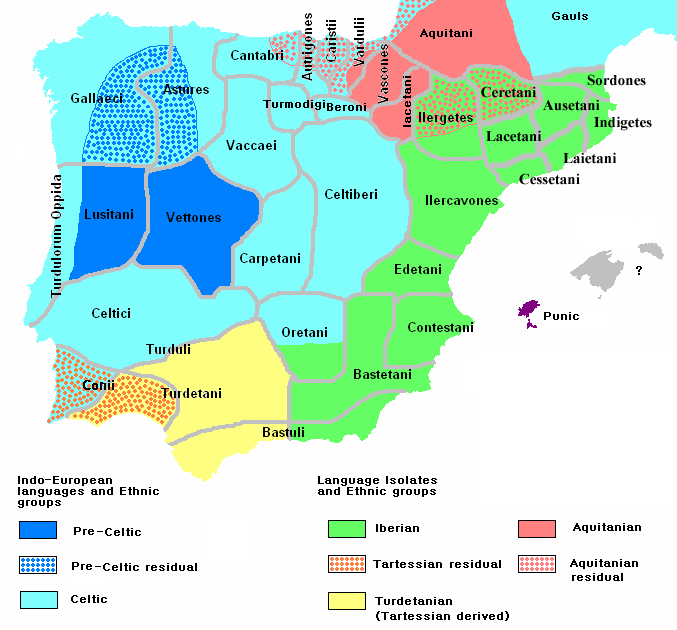 Ethnology of the Iberian Peninsula c. 200 BC The earliest record of Homo genus representatives living in Western Europe has been found in the Spanish cave of Atapuerca; a flint tool found there dates from 1.4 million years ago, and early human fossils date to roughly 1.2 million years ago.[1] Modern humans in the form of Cro-Magnons began arriving in the Iberian Peninsula from north of the Pyrenees some 35,000 years ago. The most conspicuous sign of prehistoric human settlements are the paintings in the northern Spanish cave of Altamira, which were done c. 15,000 BC.[2] Archeological evidence in places like Los Millares and El Argar suggests developed cultures existed in the eastern part of the Iberian Peninsula during the late Neolithic and the Bronze Age.[3] Around 2500 BC, the nomadic shepherds known as the Corded ware culture conquered the peninsula using new technologies and horses while killing all local males according to DNA studies.[4] Spanish prehistory extends to the pre-Roman Iron Age cultures that controlled most of Iberia: those of the Iberians, Celtiberians, Tartessians, Lusitanians, and Vascones and trading settlements of Phoenicians, Carthaginians, and Greeks on the Mediterranean coast. |
先史時代 詳細は「先史時代のイベリア半島」を参照  紀元前200年頃のイベリア半島の民族誌 西ヨーロッパに生息していたホモ属の最古の記録は、スペインのアタプエルカ洞窟で発見された。そこから発見された黒曜石の道具は140万年前のもので、初 期の人類の化石はおよそ120万年前のものである。[1] クロマニョン人のような現代の人類は、およそ3万5千年前にピレネー山脈の北からイベリア半島にやってきた。先史時代の人間の定住の最も顕著な痕跡は、ス ペイン北部のアルタミラ洞窟の壁画であり、紀元前1万5000年頃に描かれたものである。 ロス・ミジャレスやエル・アルガルなどの遺跡から、新石器時代後期から青銅器時代にかけてイベリア半島東部で高度な文化が存在していたことが考古学的証拠 から示唆されている。[3] 紀元前2500年頃、コルド文化と呼ばれる遊牧民が、新しい技術と馬を使い、半島を征服した。DNA研究によると、地元の男性は皆殺しにされたという。 [4] スペインの先史時代は、イベリア半島の大部分を支配したローマ時代以前の鉄器時代の文化にまで遡る。それらの文化には、イベリア人、ケルトイベリア人、タ ルテッソス人、ルシタニア人、バシケ人、そして地中海沿岸のフェニキア人、カルタゴ人、ギリシャ人の交易集落が含まれる。 |
| Early history of the Iberian
Peninsula Further information: Pre-Roman peoples of the Iberian Peninsula Before the Roman conquest the major cultures along the Mediterranean coast were the Iberians, the Celts in the interior and north-west, the Lusitanians in the west, and the Tartessians in the southwest. The seafaring Phoenicians, Carthaginians, and Greeks successively established trading settlements along the eastern and southern coast. The development of writing in the peninsula took place after the arrival of early Phoenician settlers and traders (tentatively dated 9th century BC or later).[5]  Illustration depicting the (now lost) Luzaga's Bronze, an example of the Celtiberian script. The south of the peninsula was rich in archaic Phoenician colonies, unmatched by any other region in the central-western Mediterranean.[6] They were small and densely packed settlements.[7] The colony of Gadir—which sustained strong links with its metropolis of Tyre—stood out from the rest of the network of colonies, also featuring a more complex sociopolitical organization.[8] Archaic Greeks arrived on the Peninsula by the late 7th century BC.[9] They founded Greek colonies such as Emporion (570 BC).[10] The Greeks are responsible for the name Iberia, apparently after the river Iber (Ebro). By the 6th century BC, much of the territory of southern Iberia passed to Carthage's overarching influence (featuring two centres of Punic influence in Gadir and Mastia); the latter grip strengthened from the 4th century BC on.[11] The Barcids, following their landing in Gadir in 237 BC, conquered the territories that belonged to the sphere of influence of Carthage.[12] Until 219 BC, their presence in the peninsula was underpinned by their control of places such as Carthago Nova and Akra Leuké (both founded by Punics), as well as the network of old Phoenician settlements.[13] 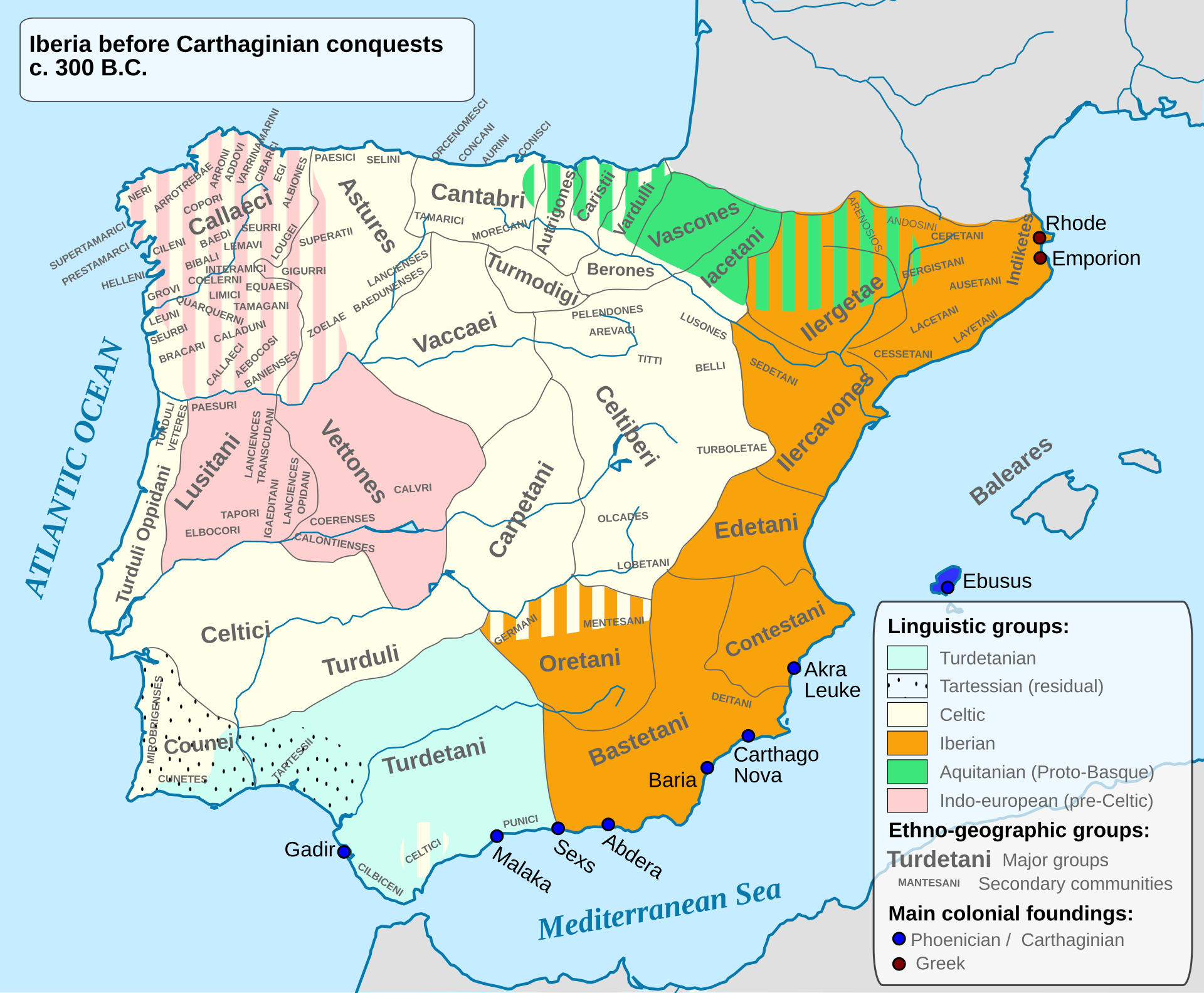 The Iberian Peninsula in the 3rd century BC The peninsula was a military theatre of the Second Punic War (218–201 BC) waged between Carthage and the Roman Republic, the two powers vying for supremacy in the western Mediterranean. Romans expelled Carthaginians from the peninsula in 206 BC.[14] The peoples whom the Romans met at the time of their invasion were the Iberians, inhabiting an area stretching from the northeast part of the Iberian Peninsula through the southeast. The Celts mostly inhabited the inner and north-west part of the peninsula. To the east of the Meseta Central, the Sistema Ibérico area was inhabited by the Celtiberians, reportedly rich in precious metals (obtained by Romans in the form of tributes).[15] Celtiberians developed a refined technique of iron-forging, displayed in their quality weapons.[16] The Celtiberian Wars were fought between the advancing legions of the Roman Republic and the Celtiberian tribes of Hispania Citerior from 181 to 133 BC.[17][18] The Roman conquest of the peninsula was completed in 19 BC. |
イベリア半島の初期の歴史 詳細情報:イベリア半島のローマ以前の民族 ローマによる征服以前、地中海沿岸の主な文化はイベリア人、内陸部および北西部のケルト人、西部のルシタニア人、南西部のタルテッシア人であった。海洋民 族であるフェニキア人、カルタゴ人、ギリシア人は、東部および南部の海岸沿いに次々と貿易植民地を築いた。半島における文字の使用は、初期のフェニキア人 入植者および貿易商の到来(暫定的に紀元前9世紀以降とされる)の後に行われた。  (現在は失われた)ルサガの青銅器を描いたイラスト。これはケルトイベ文字の一例である。 イベリア半島南部には、古代フェニキア人の植民地が豊富に存在し、地中海の中央西部のどの地域にも見られないほどであった。[6] それらは小規模で密集した集落であった。[7] ガディール植民地は、その首都であるティールとの強い結びつきを維持しており、 他の植民都市のネットワークから際立っており、より複雑な社会政治組織も特徴的であった。[8] 古代ギリシア人は、紀元前7世紀後半には半島に到達していた。[9] 彼らはエンポリオン(紀元前570年)などのギリシア植民都市を建設した。[10] イベリアという名称はギリシア人が名付けたもので、イベリア川(エブロ川)に由来すると思われる。紀元前6世紀までに、イベリア半島南部の領土の多くはカ ルタゴの支配下に入った(カルタゴの影響力はガディルとマスティアの2つの中心地に及んだ)。後者の支配力は紀元前4世紀から強まった。 カルタゴの影響下にあった地域を征服した。[12] 紀元前219年まで、半島における彼らの存在は、カルタゴ・ノヴァやアクラ・レウケ(いずれもプニキによって建設された)などの都市や、古いフェニキア人 入植地のネットワークを支配することで支えられていた。[13]  紀元前3世紀のイベリア半島 この半島は、西地中海の覇権を争う2つの大国、カルタゴとローマ共和国との間で繰り広げられた第二次ポエニ戦争(紀元前218年~201年)の戦場となっ た。 ローマ人は紀元前206年にカルタゴ人を半島から追放した。 ローマ人が侵略した当時、イベリア半島北東部から南東部にかけての地域に居住していたイベリア人に出会った。ケルト人は主に半島の内陸部と北西部に居住し ていた。メセタ中央部の東には、システマ・イベリコ地域があり、ケルトイベリア人が住んでいた。彼らは貴金属(ローマ人によって貢ぎ物として得られた)が 豊富であったと伝えられている。[15] ケルトイベリア人は洗練された鉄鍛冶の技術を発達させ、その優れた武器に表れている。[16] セルティベリア戦争は、紀元前181年から133年にかけて、ローマ共和国の進軍する軍団とヒスパニア・シテリオルのセルティベリア部族との間で戦われ た。[17][18] ローマによる半島の征服は紀元前19年に完了した。 |
| Roman Hispania (2nd century BC –
5th century AD) Main article: Hispania Further information: Roman conquest of Hispania Further information: Romanization of Hispania 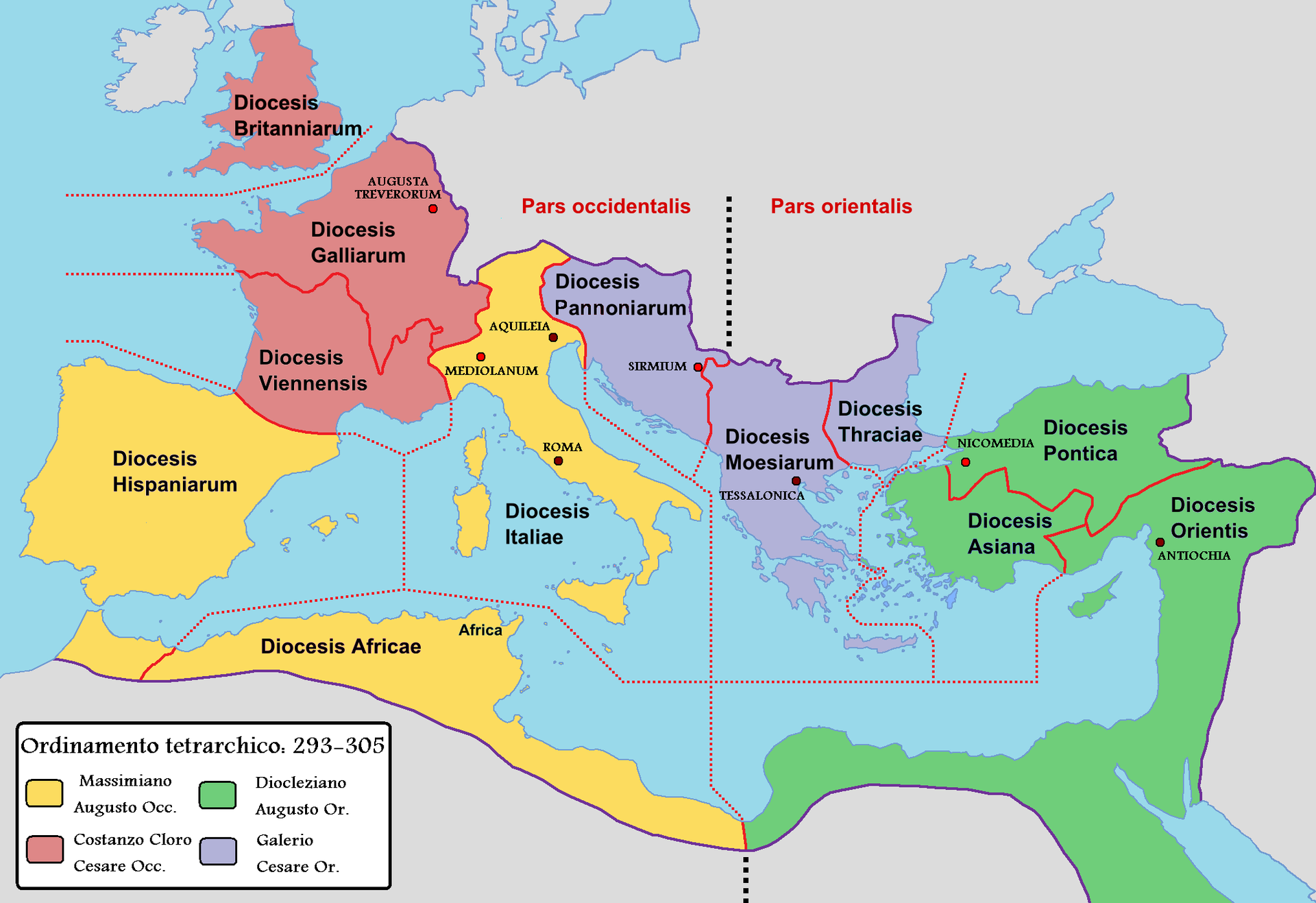 Roman Empire, 3rd century Hispania was the name used for the Iberian Peninsula under Roman rule from the 2nd century BC. The population was gradually culturally Romanized,[19] and local leaders were admitted into the Roman aristocratic class.[20] The Romans improved existing cities, such as Tarragona, and established others like Zaragoza, Mérida, Valencia, León, Badajoz, and Palencia.[21] The peninsula's economy expanded under Rome. Hispania supplied Rome with food, olive oil, wine and metal. The emperors Trajan, Hadrian, and Theodosius I, the philosopher Seneca, and the poets Martial, Quintilian, and Lucan were born in Hispania. Hispanic bishops held the Council of Elvira around 306. After the fall of the Western Roman Empire in the 5th century, parts of Hispania came under the control of the Germanic tribes of Vandals, Suebi, and Visigoths. The collapse of the Western Roman Empire did not lead to the same wholesale destruction of classical society as happened in areas like Roman Britain, Gaul and Germania Inferior during the Early Middle Ages, although the institutions and infrastructure did decline. Spain's languages, its religion, and the basis of its laws originate from this period. |
ローマ帝国のヒスパニア(紀元前2世紀 - 紀元後5世紀) 詳細は「ヒスパニア」を参照 さらに詳しい情報: ローマ帝国によるヒスパニア征服 さらに詳しい情報: ヒスパニアのローマ化  ローマ帝国、3世紀 ヒスパニアは、紀元前2世紀以降、ローマの支配下にあったイベリア半島を指す名称であった。人口は徐々に文化的にローマ化され[19]、地元の指導者たち はローマの貴族階級に受け入れられた[20]。 ローマ人はタラゴナ(Tarragona)などの既存の都市を整備し、サラゴサ(Zaragoza)、メリーダ(Mérida)、バレンシア (Valencia)、レオン(León)、バダホス(Badajoz)、パレンシア(Palencia)などの都市を新たに建設した。半島の経済はロー マの支配下で拡大した。ヒスパニアはローマに食料、オリーブオイル、ワイン、金属を供給した。皇帝トラヤヌス、ハドリアヌス、テオドシウス1世、哲学者セ ネカ、詩人マルティアル、クインティリアヌス、ルカヌスはヒスパニアで生まれた。306年頃、ヒスパニア出身の司教たちがエルビラ公会議を開催した。 5世紀に西ローマ帝国が滅亡した後、ヒスパニアの一部はヴァンダル族、スエビ族、西ゴート族といったゲルマン民族の支配下に入った。 西ローマ帝国の崩壊は、初期中世のローマ・ブリテン、ガリア、ゲルマニア・インフェリオルといった地域で起こったような古典的社会の全面的な破壊にはつな がらなかったが、制度やインフラは衰退した。スペインの言語、宗教、法律の基礎は、この時代に起源を持つ。 |
| Gothic Hispania (5th–8th
centuries) See also: Spain in the Middle Ages § Early medieval Spain Further information: Visigothic Kingdom, Suebic Kingdom of Galicia, and Spania 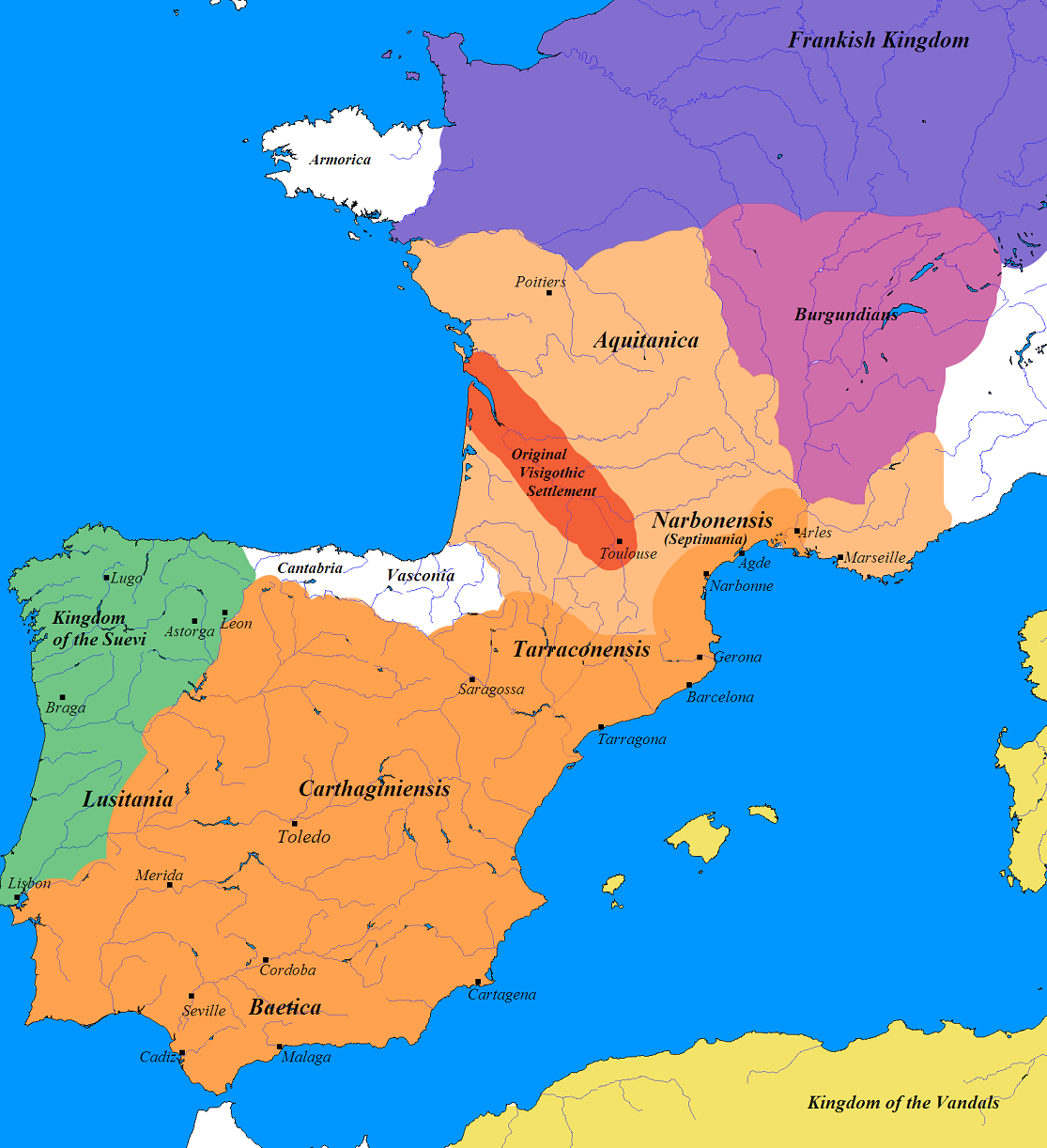 The greatest extent of the Visigothic Kingdom of Toulouse, c. 500, showing Territory lost after Vouillé in light orange The first Germanic tribes to invade Hispania arrived in the 5th century, as the Roman Empire decayed.[22] The Visigoths, Suebi, Vandals and Alans arrived in Hispania by crossing the Pyrenees mountain range, leading to the establishment of the Suebi Kingdom in Gallaecia, in the northwest, the Vandal Kingdom of Vandalusia (Andalusia), and the Visigothic Kingdom in Toledo. The Romanized Visigoths entered Hispania in 415. After the conversion of their monarchy to Roman Catholicism and after conquering the disordered Suebic territories in the northwest and Byzantine territories in the southeast, the Visigothic Kingdom eventually encompassed a great part of the peninsula.[20][23] As Rome declined, Germanic tribes invaded the former empire. Some were foederati, tribes enlisted to serve in Roman armies and given land as payment, while others, such as the Vandals, took advantage of the empire's weakening defenses to plunder. Those tribes that survived took over existing Roman institutions, and created successor-kingdoms to the Romans in various parts of Europe. Hispania was taken over by the Visigoths after 410.[24] At the same time, there was a process of "Romanization" of the Germanic and Hunnic tribes. The Visigoths, for example, were converted to Arian Christianity around 360, even before they were pushed into imperial territory by the expansion of the Huns.[25] The Visigoths, having sacked Rome two years earlier, arrived in Gaul in 412, founding the Visigothic kingdom of Toulouse (in the south of modern France) and gradually expanded their influence into Hispania after the battle of Vouillé (507) at the expense of the Vandals and Alans, who moved on into North Africa without leaving much permanent mark on Hispanic culture. The Visigothic Kingdom shifted its capital to Toledo and reached a high point during the reign of Leovigild. |
ゴシック・イスパニア(5世紀~8世紀) 参照:中世のスペイン § 中世前期のスペイン 詳細情報:西ゴート王国、ガリシア・スエビ王国、スペイン王国  西ゴート王国の最大版図(500年頃) ヴイレの戦い後に失った領土は薄いオレンジ色で示す ローマ帝国が衰退する中、5世紀にイベリア半島に侵入した最初のゲルマン部族が到着した。[22] ビスゴート族、スエビ族、ヴァンダル族、アラン族がピレネー山脈を越えてイベリア半島に到着し、北西部のガラエキアにスエビ王国、ヴァンダルシア(アンダ ルシア)にヴァンダル王国、トレドにビスゴート王国がそれぞれ建国された。ローマ化した西ゴート族は415年にヒスパニアに進出した。西ゴート族は、君主 制をローマ・カトリックに改宗し、北西部の混乱したスエビ族の領土と南東部のビザンティン領土を征服した後、最終的に半島の大部分を包含するに至った。 ローマが衰退すると、ゲルマン民族が旧帝国に侵入した。一部はローマ軍に協力する部族としてローマ軍に協力し、その見返りとして土地を与えられたが(フェ デラティ)、ヴァンダル族のように帝国の防衛力の低下に乗じて略奪を行う部族もいた。生き残った部族はローマの既存の制度を引き継ぎ、ヨーロッパ各地に ローマ人の後継国家を築いた。410年以降、ヒスパニアは西ゴート族に占領された。 同じ頃、ゲルマン族やフン族の間でも「ローマ化」が進んだ。例えば西ゴート族は、フン族の拡大により帝国領内に押し込まれるよりも前の360年頃にはアリ ウス派キリスト教に改宗していた。 西ゴート族は2年前にローマを略奪した後、412年にガリアに到着し、トゥールーズ(現在のフランス南部)に西ゴート王国を建国した。そして、ヴイレの戦 い(507年)の後、徐々にヒスパニアに勢力を拡大し、ヴァンダル族とアラン族を追いやり、彼らは北アフリカに移住したが、イベリア文化に永続的な影響を ほとんど残さなかった。西ゴート王国は首都をトレドに移し、レオビギルドの治世下で最盛期を迎えた。 |
| Visigothic rule Main article: Visigothic Kingdom. 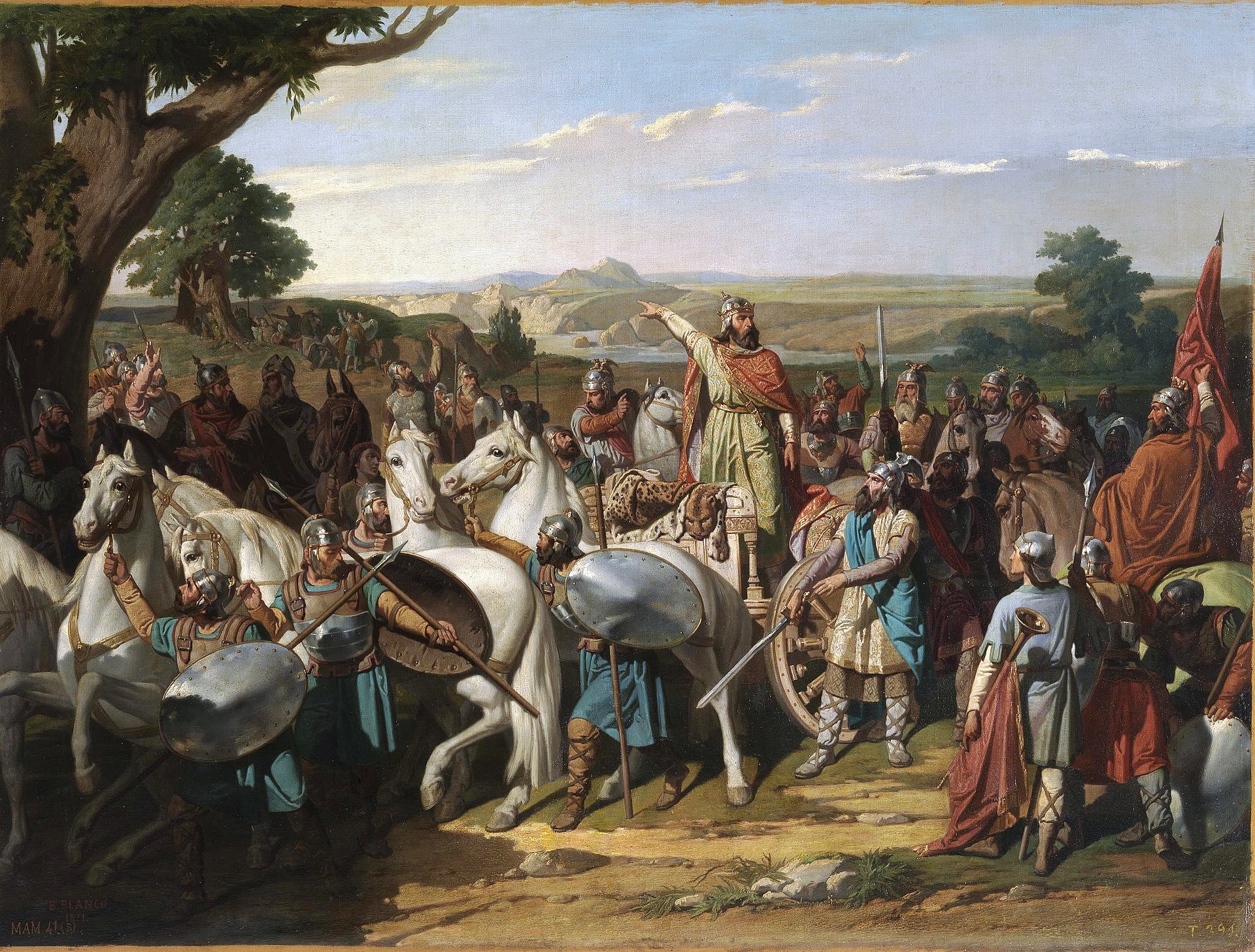 Visigothic King Roderic haranguing his troops before the Battle of Guadalete The Visigothic Kingdom conquered all of Hispania and ruled it until the early 8th century, when the peninsula fell to the Muslim conquests. The Muslim state in Hispania came to be known as Al-Andalus. After a period of Muslim dominance, the medieval history of Spain is dominated by the long Christian Reconquista or "reconquest" of the Iberian Peninsula. The Reconquista gathered momentum during the 12th century, leading to the establishment of the Christian kingdoms of Portugal, Aragon, Castile and Navarre and by 1250, had reduced Muslim control to the Emirate of Granada in the south-east. Muslim rule in Granada survived until 1492, when it fell to the Catholic Monarchs. Hispania never saw a decline in interest in classical culture to the degree observable in Britain, Gaul, and Germany. The Visigoths, having assimilated Roman culture and language during their tenure as foederati, maintained more of the old Roman institutions. They had a unique respect for legal codes that resulted in continuous frameworks and historical records for most of the period between 415, when Visigothic rule in Hispania began, and 711 when it is traditionally said to end.[26] The Liber Iudiciorum or Lex Visigothorum (654), also known as the Book of Judges, which Recceswinth promulgated, based on Roman law and Germanic customary laws, brought about legal unification. According to the historian Joseph O'Callaghan, at that time they already considered themselves one people and together with the Hispano-Gothic nobility they called themselves the gens Gothorum.[27] In the early Middle Ages, the Liber Iudiciorum was known as the Visigothic Code and also as the Fuero Juzgo. Its influence on law extends to the present. The proximity of the Visigothic kingdoms to the Mediterranean and the continuity (though reduced) of western Mediterranean trade supported Visigothic culture. The Visigothic ruling class looked to Constantinople for style and technology. Spanish Catholicism also coalesced during this time. The period of rule by the Visigothic Kingdom saw the spread of Arianism briefly in Hispania.[28] The Councils of Toledo debated creed and liturgy in orthodox Catholicism, and the Council of Lerida in 546 constrained the clergy and extended the power of law over them with the approval of the Pope. In 587, the Visigothic king at Toledo, Reccared, converted to Catholicism and launched a movement to unify the various religious doctrines in Hispania. The Visigoths inherited from Late Antiquity a prefeudal system in Hispania,[29] based in the south on the Roman villa system and in the north drawing on their vassals to supply troops in exchange for protection. The bulk of the Visigothic army was composed of slaves. The loose council of nobles that advised Hispania's Visigothic kings and legitimized their rule was responsible for raising the army, and only upon its consent was the king able to summon soldiers. The economy of the Visigothic kingdom depended primarily on agriculture and animal husbandry; there is little evidence of Visigothic commerce and industry.[30] The native Hispani maintained the cultural and economic life of Hispania and were responsible for the relative prosperity of the 6th and 7th centuries. Administration was still based on Roman law, and only gradually did Visigothic customs and Roman common law merge.[31] The Visigoths did not, until the period of Muslim rule, intermarry with the Spanish population, and the Visigothic language had a limited impact on the modern languages of Iberia.[32] The historian Joseph F. O'Callaghan says that at the end of the Visigothic era the assimilation of Hispano-Romans and Visigoths was occurring rapidly, and the leaders of society were beginning to see themselves as one people.[27] Little literature in the Gothic language remains from the period of Visigothic rule—only translations of parts of the Greek Bible and a few fragments of other documents have survived.[33] The Hispano-Romans found Visigothic rule and its early embrace of the Arian heresy more of a threat than Islam, and shed their thralldom to the Visigoths only in the 8th century, with the aid of the Muslims themselves.[34] The most visible effect of Visigothic rule was the depopulation of the cities as their inhabitants moved to the countryside. Even while the country enjoyed a degree of prosperity when compared to France and Germany, the Visigoths felt little reason to contribute to the welfare, permanency, and infrastructure of their people and state. This contributed to their downfall, as they could not count on the loyalty of their subjects when the Moors arrived in the 8th century.[32] |
西ゴート族の支配(415-711) 詳細は「西ゴート王国」を参照  グアダレーテの戦いの前に兵士たちを鼓舞する西ゴート族の王ロデリック 西ゴート王国はヒスパニア全土を征服し、半島がイスラム教徒の征服下に落ちた8世紀初頭まで統治した。ヒスパニアのイスラム教徒国家は、アル・アンダルス として知られるようになった。イスラム教徒が支配した時代を経て、スペインの中世史はイベリア半島におけるキリスト教徒による長いレコンキスタ(国土回復 運動)によって特徴づけられる。レコンキスタは12世紀に勢いを増し、ポルトガル、アラゴン、カスティーリャ、ナバーラのキリスト教王国の樹立につながっ た。1250年までに、イスラム教徒の支配は南東部のグラナダ首長国にまで縮小した。グラナダのイスラム教徒支配は1492年まで続き、この年、カトリッ ク両王によって征服された。 イベリア半島では、イギリス、ガリア、ドイツで観察されるほど古典文化への関心が衰えることはなかった。ローマと同盟関係(foederati)にあった 期間にローマの文化や言語を吸収した西ゴート族は、ローマの古い制度をより多く維持した。彼らは法体系に対して独特の敬意を抱いており、それが西ゴート族 によるヒスパニア支配が始まった415年から、それが伝統的に終わったとされる711年までのほとんどの期間において、継続的な枠組みと歴史的記録をもた らした。 26] レキエスウィンドが公布した『自由民の法典』または『西ゴート人の法典』(654年)は、ローマ法とゲルマン慣習法を基にしており、「判事の書」としても 知られ、法の統一をもたらした。歴史家のジョセフ・オキャラハンによると、当時すでに彼らは自分たちをひとつの民族と考え、ヒスパノ・ゴート族の貴族たち とともに自分たちをゲンス・ゴトルム(Gens Gothorum)と呼んでいたという。[27] 中世初期には、リベル・ユディキオルムは西ゴート法典(Visigothic Code)やフエロ・フスゴ(Fuero Juzgo)として知られていた。その法への影響は現在まで及んでいる。 西ゴート王国が地中海に近かったこと、また(縮小はしたものの)西地中海貿易が継続したことが、西ゴート文化を支えた。西ゴートの支配階級は、様式や技術 をコンスタンティノープルに求めた。 スペインのカトリックもこの時代に統合された。西ゴート王国による統治期間中、ヒスパニアでは一時的にアリウス主義が広まった。[28] トレド公会議では正統派カトリックの信条と典礼について議論され、546年のレリダ公会議では教皇の承認のもと、聖職者を拘束し、彼らに対する法の力を拡 大した。587年、トレドの西ゴート族の王レケドはカトリックに改宗し、ヒスパニアのさまざまな宗教的教義を統一する運動を開始した。 西ゴート族は古代末期からヒスパニアに存在していた封建制以前の制度を継承していたが、それは南部ではローマのヴィラ制度を基盤とし、北部では保護の見返 りとして家臣団から兵士を徴発する制度であった。西ゴート軍の大半は奴隷で構成されていた。西ゴート族の王に助言を与え、その統治を正当化する貴族たちの 緩やかな協議会が軍の編成を担当し、王が兵士を召集できるのは、協議会の同意があった場合のみであった。 西ゴート王国の経済は主に農業と畜産業に依存しており、西ゴート王国の商業や工業を示す証拠はほとんどない。[30] スペイン原住民は、ヒスパニアの文化と経済を維持し、6世紀と7世紀の相対的な繁栄を支えた。行政は依然としてローマ法に基づいており、西ゴートの慣習法 とローマの一般法が徐々に融合していった。[31] 西ゴート族はイスラム教徒の支配下に入るまでスペインの住民と婚姻関係を結ぶことはなく、西ゴート語はイベリア半島の現代の言語に与えた影響は限定的で あった。[32] 歴史家のジョセフ・F・オキャラハンは、西ゴート族の時代末期には ヒスパノ・ローマ人と西ゴート族の同化が急速に進行し、社会の指導者たちは自分たちを一つの民族として認識し始めていた。[27] 西ゴート族支配期のゴート語の文献はほとんど残っていない。ギリシャ語聖書の翻訳の一部と、いくつかの断片的な文書のみが現存している。[33] イスパノ・ローマ人にとって、西ゴート族の支配や初期のアリウス派異端の受け入れは、イスラム教よりも脅威であり、西ゴート族の支配から解放されたのは、 8世紀になってイスラム教徒の助力を得てからであった。[34] 西ゴート族の支配による最も顕著な影響は、住民が田舎に移住したことによる都市の過疎化であった。フランスやドイツと比較すると、この国はある程度の繁栄 を享受していたが、西ゴート族は自国民や国家の福祉、永続性、インフラ整備に貢献する理由をほとんど感じていなかった。これが彼らの没落につながった。8 世紀にムーア人が到来した際、彼らは臣民の忠誠を当てにすることができなかったのだ。[32] |
Goldsmithery in Visigothic
Hispania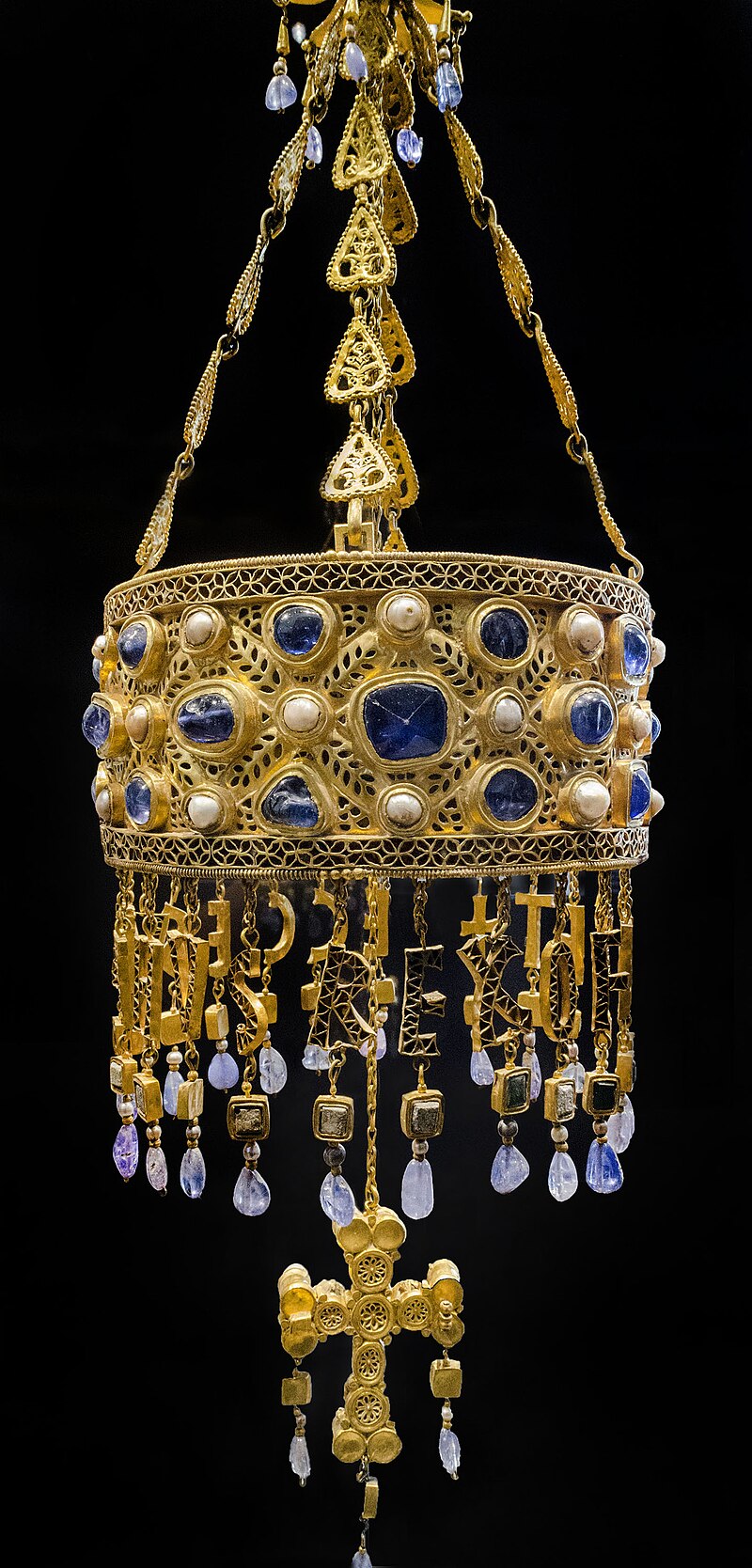 Detail of the votive crown of Recceswinth from the Treasure of Guarrazar, (Toledo-Spain) hanging in Madrid. The hanging letters spell [R]ECCESVINTHVS REX OFFERET [King R. offers this].[a] In Spain, an important collection of Visigothic metalwork was found in Guadamur, known as the Treasure of Guarrazar. This archeological find comprises twenty-six votive crowns and gold crosses from the royal workshop in Toledo, with signs of Byzantine influence. Two important votive crowns are those of Recceswinth and of Suintila, displayed in the National Archaeological Museum of Madrid; both are made of gold, encrusted with sapphires, pearls, and other precious stones. Suintila's crown was stolen in 1921 and never recovered. There are several other small crowns and many votive crosses in the treasure. The aquiliform (eagle-shaped) fibulae that have been discovered in necropolises such as Duraton, Madrona or Castiltierra cities of Segovia. These fibulae were used individually or in pairs, as clasps or pins in gold, bronze and glass to join clothes. The Visigothic belt buckles, a symbol of rank and status characteristic of Visigothic women's clothing, are also notable as works of goldsmithery. Some pieces contain exceptional Byzantine-style lapis lazuli inlays and are generally rectangular in shape, with copper alloy, garnets and glass.[35][b] |
西ゴート王国時代の金細工 マドリードに展示されている、スペイン・トレドのグアラサール財宝に含まれるレキセスウィント王の奉納冠の細部。垂れ下がった文字は[R] ECCESVINTHVS REX OFFERET(レキセスウィント王が奉納)と書かれている。 スペインでは、グアダムールで西ゴート族の重要な金属細工コレクションが発見された。これは「グアラサール遺宝」として知られている。この考古学的発見 は、トレドの王立工房で製作された26の奉納用王冠と金十字架からなり、ビザンチン帝国の影響が見られる。 重要な奉納冠として、レセスウィントス王とスィンティラ王の冠があり、マドリード国立考古学博物館に展示されている。いずれも金製で、サファイアや真珠、 その他の貴石がちりばめられている。スィンティラ王の冠は1921年に盗まれ、いまだ発見されていない。この財宝には、この他にもいくつかの小さな冠と多 くの奉納十字架がある。 セゴビアの都市であるドゥラトン、マドロナ、カスティリェラなどのネクロポリスで発見された鷲の形をしたフィブラ(留め具)。これらのフィブラは、金、青 銅、ガラス製の留め具やピンとして、単独またはペアで使用され、衣服を留めるために使用されていた。 西ゴート族のベルトバックルは、西ゴート族の女性服の特徴である地位と身分を象徴するものであり、金細工品としても注目に値する。一部の作品には、非常に 優れたビザンチン様式のラピスラズリの象嵌が施されており、一般的には長方形で、銅合金、ガーネット、ガラスが使用されている。[35][b] |
| Architecture of Visigothic
Hispania Main article: Visigothic art and architecture 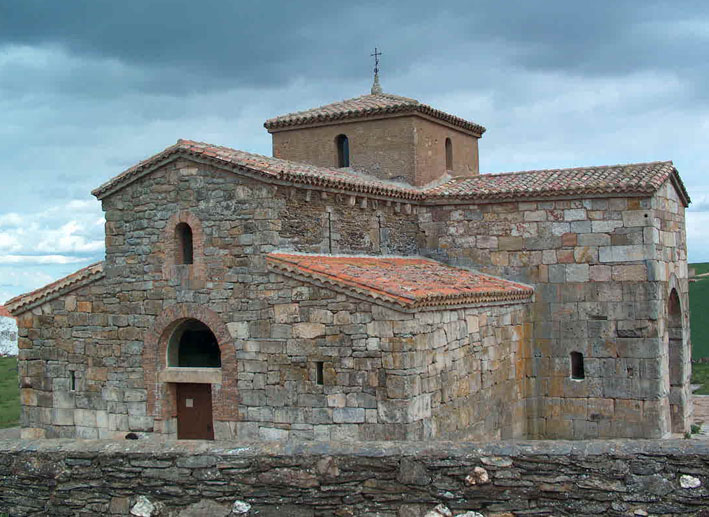 Visigothic church, San Pedro de la Nave. Zamora. Spain During their governance of Hispania, the Visigoths built several churches in the basilical or cruciform style that survive, including the churches of San Pedro de la Nave in El Campillo, Santa María de Melque in San Martín de Montalbán, Santa Lucía del Trampal in Alcuéscar, Santa Comba in Bande, and Santa María de Lara in Quintanilla de las Viñas.[citation needed] The Visigothic crypt (the Crypt of San Antolín) in the Palencia Cathedral is a Visigothic chapel from the mid 7th century, built during the reign of Wamba to preserve the remains of the martyr Saint Antoninus of Pamiers. These are the only remains of the Visigothic cathedral of Palencia.[37] Reccopolis, located near the tiny modern village of Zorita de los Canes, is an archaeological site of one of at least four cities founded in Hispania by the Visigoths. It is the only city in Western Europe to have been founded between the fifth and eighth centuries.[c] The city's construction was ordered by the Visigothic king Liuvigild to honor his son Reccared and to serve as Reccared's seat as co-king in the Visigothic province of Celtiberia.[38] |
西ゴート族支配下のヒスパニアの建築 詳細は「西ゴート族の芸術と建築」を参照  西ゴート族の教会、サン・ペドロ・デ・ラ・ナベ。スペイン、サモラ 西ゴート族は、ヒスパニアを統治していた時代に、バシリカ様式や十字形の教会をいくつか建設した。そのうち現存するものには、エル・カンピージョのサン・ ペドロ・デ・ラ・ナベ教会、サン・マルティン・デ・モンタルバンのサンタ・マリア・デ・メルケ教会、アルクエスカルのサンタ・ルシア・デル・トランパル教 会、バンドのサンタ・コンバ教会、 サンタ・マリア・デ・ララ(Quintanilla de las Viñas)などがある。[要出典] パレンシア大聖堂の西ゴート時代の地下聖堂(サン・アントリンの地下聖堂)は、7世紀半ばの西ゴート時代の礼拝堂であり、ヴァンバ王の治世下で殉教者聖ア ントニヌス・パミエの遺体を保存するために建てられた。これはパレンシアの西ゴート時代の大聖堂の唯一の遺構である。[37] レコポリスは、現代の小さな村ゾリータ・デ・ロス・カネス(Zorita de los Canes)の近くに位置し、西ゴート族がヒスパニアに建設した4つの都市のうちの1つの遺跡である。西ヨーロッパで5世紀から8世紀の間に建設された唯 一の都市である。この都市は、西ゴート族の王リウビギルドが、息子レケドを称えるために建設を命じたもので、レケドが西ゴート族のセルティベリア地方の共 同王として君臨するための拠点となった。 |
| Religion Further information: History of Roman Catholicism in Spain § Visigoths At the beginning of the Visigothic Kingdom, Arianism was the official religion in Hispania, but only for a brief time, according to historian Rhea Marsh Smith.[28] In 587, Reccared, the Visigothic king at Toledo, converted to Catholicism and launched a movement to unify the religious doctrines that existed in the Iberian Peninsula. The Councils of Toledo debated the creed and liturgy of orthodox Catholicism, and the Council of Lerida in 546 constrained the clergy and extended the power of law over them with the approval of the pope. While the Visigoths clung to their Arian faith, the Jews were well-tolerated. Previous Roman and Byzantine law determined their status, and already sharply discriminated against them.[39] Historian Jane Gerber relates that some of the Jews "held ranking posts in the government or the army; others were recruited and organized for garrison service; still others continued to hold senatorial rank".[40] In general, they were well-respected and well-treated by the Visigothic kings, until their transition from Arianism to Catholicism.[41] Conversion to Catholicism across Visigothic society reduced the friction between the Visigoths and the Hispano-Roman population.[42] However, the Visigothic conversion negatively impacted the Jews, who came under scrutiny for their religious practices.[43] |
宗教 詳細情報:スペインにおけるローマ・カトリックの歴史 § 西ゴート族 西ゴート族王国の初期には、ヒスパニアではアリウス派が国教とされていたが、歴史家リア・マーシュ・スミスによると、それはごく短期間であった。587 年、トレドの西ゴート族王レキッドはカトリックに改宗し、イベリア半島に存在した宗教的教義を統一する運動を開始した。トレド公会議では正統派カトリック の信条と典礼について討議され、546年のレリダ公会議では教皇の承認のもと、聖職者を拘束し、彼らに対する法の力を拡大した。 西ゴート族がアリウス派信仰に固執する一方で、ユダヤ人は寛容に扱われた。それ以前のローマ法とビザンチン法によって彼らの地位が決定され、すでに彼らに 対する差別は顕著であった。[39] 歴史家のジェーン・ガーバーは、ユダヤ人の一部は「政府や軍隊で高位の役職に就き、また、徴兵されて駐屯地勤務に就く者もおり、さらに元老院議員としての 地位を維持し続けた者もいた」と述べている。[40] 一般的に、彼らは西ゴート族の王たちから尊敬され、 西ゴート族の王たちから厚遇されていたが、アリウス派からカトリックへと転向するまではそうであった。[41] 西ゴート族社会全体でカトリックへの改宗が進んだことで、西ゴート族とヒスパノ・ローマ人との間の摩擦は減少した。[42] しかし、西ゴート族の改宗はユダヤ人にとってマイナスとなり、彼らの宗教的慣習は厳しく監視されるようになった。[43] |
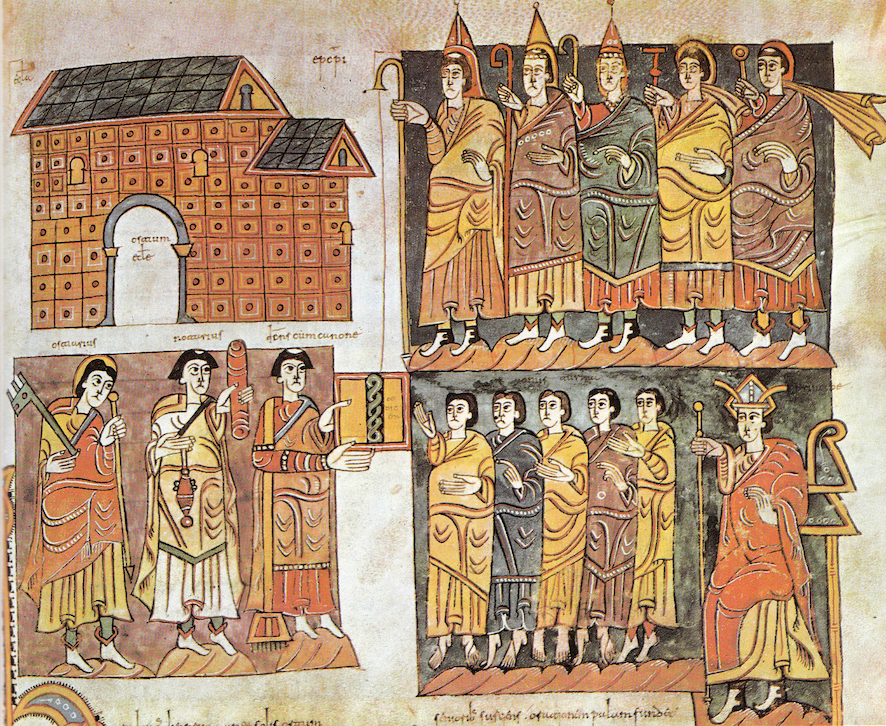 Nobles and clerics attending to a council in Toledo as depicted in the 976 Codex Vigilanus. |
 976年のCodex Vigilanusに描かれた、トレドの会議に出席する貴族と聖職者。 |
| Islamic al-Andalus and the
Christian Reconquest (8th–15th centuries) Main articles: Umayyad conquest of Hispania, Al-Andalus, Spain in the Middle Ages, and Reconquista 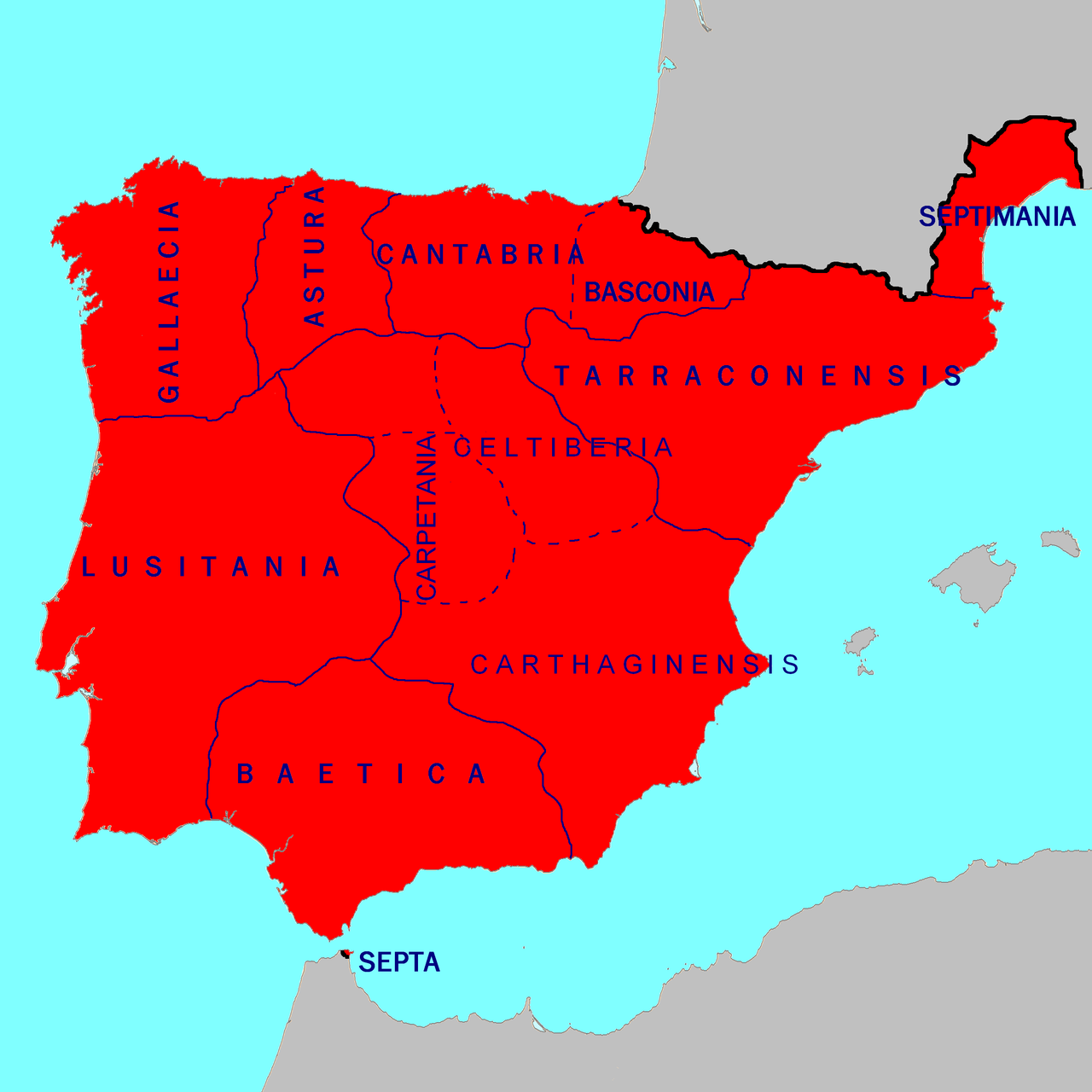 Visigothic Hispania and its regional divisions in 700, prior to the Muslim conquest 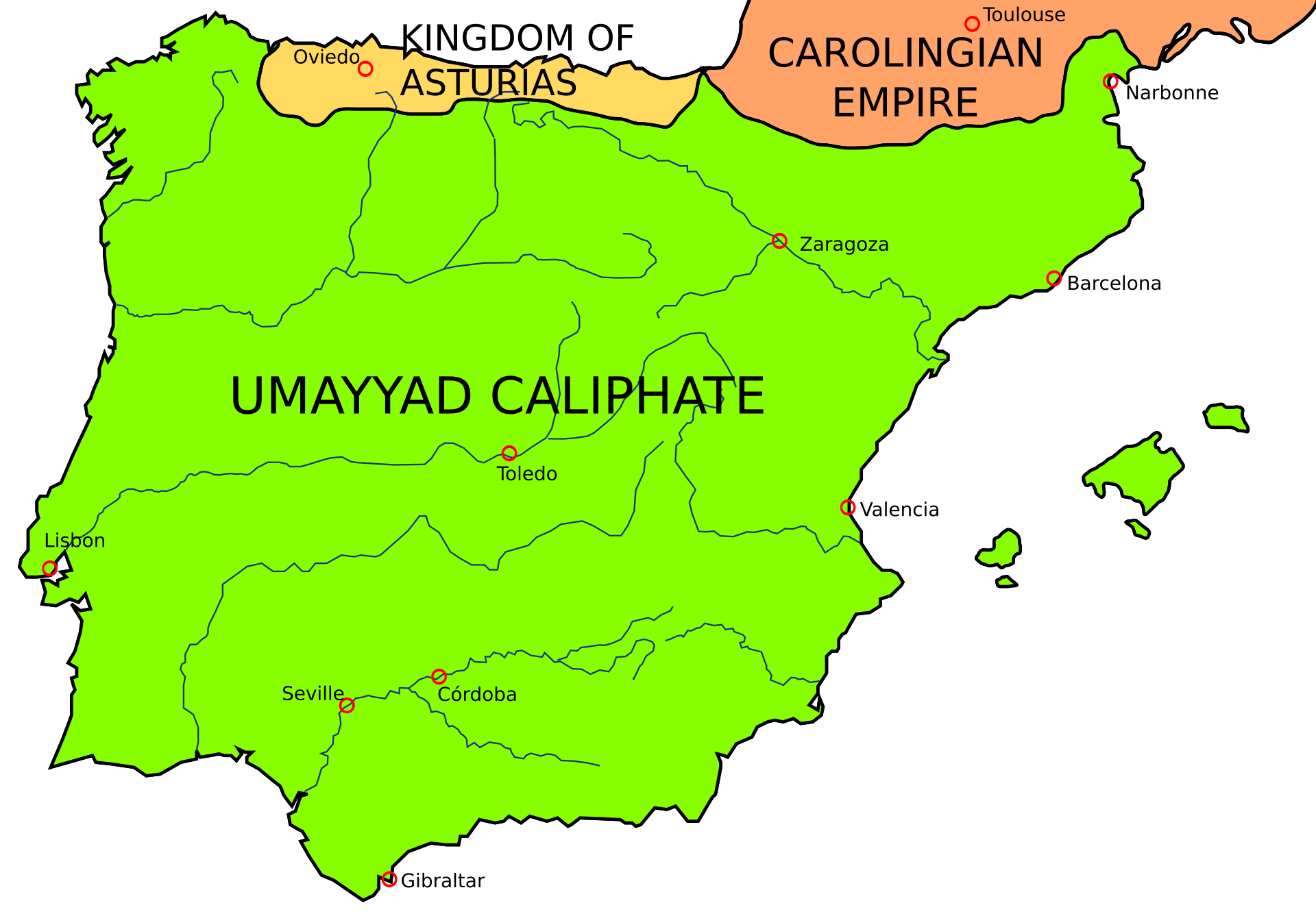 al-Andalus at its greatest extent, 720 The Umayyad Caliphate dominated most of North Africa by 710 AD. In 711 an Islamic Berber conquering party, led by Tariq ibn Ziyad, was sent to Hispania to intervene in a civil war in the Visigothic Kingdom.[44] Crossing the Strait of Gibraltar, they won a decisive victory in the summer of 711 when the Visigothic King Roderic was defeated and killed on July 19 at the Battle of Guadalete. Tariq's commander, Musa, quickly crossed with Arab reinforcements, and by 718 the Muslims were in control of nearly the whole Iberian Peninsula. The advance into Western Europe was only stopped in what is now north-central France by the West Germanic Franks under Charles Martel at the Battle of Tours in 732. The Muslim conquerors (also known as "Moors") were Arabs and Berbers; following the conquest, conversion and arabization of the Hispano-Roman population took place,[45] (muwalladum or Muwallad).[46][47] After a long process, spurred on in the 9th and 10th centuries, the majority of the population in Al-Andalus converted to Islam.[48] The Muslim population was divided per ethnicity (Arabs, Berbers, Muwallad), and the supremacy of Arabs over the rest of group was a recurrent cause for strife, rivalry and hatred, particularly between Arabs and Berbers.[49] Arab elites could be further divided in the Yemenites (first wave) and Syrians (second wave).[50] Male Muslim rulers were often the offspring of female Christian slaves.[51] Christians and Jews were allowed to live as subordinate groups of a stratified society under the dhimmah system,[52] although Jews became very important in certain fields.[53] Some Christians migrated to the Northern Christian kingdoms, while those who stayed in Al-Andalus progressively arabised and became known as musta'arab (mozarabs).[54] Besides slaves of Iberian origin,[51] the slave population also comprised the Ṣaqāliba (literally meaning "slavs", although they were slaves of generic European origin) as well as Sudanese slaves.[55] The frequent raids in Christian lands provided Al-Andalus with continuous slave stock, including women who often became part of the harems of the Muslim elite.[51] Slaves were also shipped from Spain to elsewhere in the Ummah.[51] In what should not have amounted to much more than a skirmish (later magnified by Spanish nationalism),[56][57] a Muslim force sent to put down the Christian rebels in the northern mountains was defeated by a force reportedly led by Pelagius, known as the Battle of Covadonga. The figure of Pelagius, a by-product of the Asturian chronicles of Alfonso III (written more than a century after the alleged battle), has been later reconstructed in conflicting historiographical theories, most notably that of a refuged Visigoth noble or an autochthonous Astur chieftain.[58] The consolidation of a Christian polity that came to be known as the Kingdom of Asturias ensued later. At the end of Visigothic rule, the assimilation of Hispano-Romans and Visigoths was occurring rapidly. An unknown number fled and took refuge in Asturias or Septimania. In Asturias they supported Pelagius's uprising, and joining with the indigenous leaders, formed a new aristocracy. The population of the mountain region consisted of native Astures, Galicians, Cantabri, Basques and other groups unassimilated into Hispano-Gothic society.[27] In 739, a rebellion in Galicia, assisted by the Asturians, drove out Muslim forces and it joined the Asturian kingdom. In the northern Christian kingdoms, lords and religious organizations often owned Muslim slaves who were employed as laborers and household servants.[51] Caliph Al-Walid I had paid great attention to the expansion of an organized military, building the strongest navy in the Umayyad Caliphate era (the second major Arab dynasty after Mohammad and the first Arab dynasty of Al-Andalus). It was this tactic that supported the ultimate expansion to Hispania. Islamic power in Spain specifically climaxed in the 10th century under Abd-al-Rahman III.[59] The rulers of Al-Andalus were granted the rank of Emir by the Umayyad Caliph Al-Walid I in Damascus. When the Abbasids overthrew the Umayyad Caliphate, Abd al-Rahman I managed to escape to al-Andalus and declared it independent. The state founded by him is known as the Emirate of Cordoba. Al-Andalus was rife with internal conflict between the Islamic Umayyad rulers and people and the Christian Visigoth-Roman leaders and people. 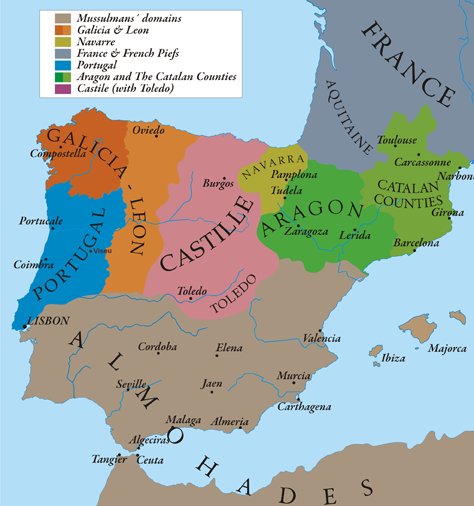 The Christian kingdoms of Hispania and the Islamic Almohad empire c. 1210 The Vikings invaded Galicia in 844, but were heavily defeated by Ramiro I at A Coruña.[60] Many of the Vikings' casualties were caused by the Galicians' ballistas – powerful torsion-powered projectile weapons that looked rather like giant crossbows.[60] 70 Viking ships were captured and burned.[60][61] Vikings returned to Galicia in 859, during the reign of Ordoño I. Ordoño was at the moment engaged against his constant enemies the Moors; but a count of the province, Don Pedro, attacked the Vikings and defeated them,[62] destroying 38 of their ships. In the 10th century Abd-al-Rahman III declared the Caliphate of Córdoba, effectively breaking all ties with the Egyptian and Syrian caliphs. The Caliphate was mostly concerned with maintaining its power base in North Africa, but these possessions eventually dwindled to the Ceuta province. The first navy of the Emir of Córdoba was built after the Viking ascent of the Guadalquivir in 844 when they sacked Seville.[63] In 942, Hungarian raids on Spain, especially in Catalonia,[64] took place, according to Ibn Hayyan's work.[65][63] Meanwhile, a slow but steady migration of Christian subjects to the northern kingdoms in Christian Hispania was slowly increasing the latter's power. Al-Andalus coincided with La Convivencia, an era of relative religious tolerance, and with the Golden age of Jewish culture in the Iberian Peninsula.[66] Muslim interest in the peninsula returned in force around the year 1000 when Al-Mansur (Almanzor) sacked Barcelona in 985, and he assaulted Zamora, Toro, Leon and Astorga in 988 and 989, which controlled access to Galicia.[67] Under his son, other Christian cities were subjected to numerous raids.[68] After his son's death, the caliphate plunged into a civil war and splintered into the so-called "Taifa Kingdoms". The Taifa kings competed in war and in the protection of the arts, and culture enjoyed a brief renaissance. The aceifas (Muslim military expeditions made in summer in medieval Spain) were the continuation of a policy from the times of the emirate: the capture of numerous contingents of Christian slaves, the saqáliba (plural of siqlabi, "slave").[69] These were the most lucrative part of the booty, and constituted an excellent method of payment for the troops, so much so that many aceifas were hunts for people. The Almohads, who had taken control of the Almoravids' Maghribi and al-Andalus territories by 1147, surpassed the Almoravides in fundamentalist Islamic outlook, and they treated the non-believer dhimmis harshly. Faced with the choice of death, conversion, or emigration, many Jews and Christians left.[70] By the mid-13th century, the Emirate of Granada was the only independent Muslim realm in Spain, which survived until 1492 by becoming a vassal state to Castile, to which it paid tribute. |
イスラム教徒の支配下にあったスペイン(アル・アンダルス)とキリスト
教徒によるレコンキスタ(8世紀~15世紀) 主な記事:ウマイヤ朝によるスペイン征服、アル・アンダルス、中世のスペイン、レコンキスタ  イスラム教徒による征服前の700年の西ゴート族のヒスパニアとその地域区分  720年の最大版図のアル・アンダルス ウマイヤ朝は、西暦710年までに北アフリカの大半を支配下に置いていた。711年、イスラム教徒のベルベル人部隊が、タリク・イブン・ズィヤドの指揮の 下、西ゴート王国の内戦に介入するためにヒスパニアに派遣された。[44] ジブラルタル海峡を渡った彼らは、711年の夏に決定的な勝利を収めた。西ゴートの王ロデリックは、7月19日のグアダレーテの戦いで敗北し、戦死した。 タリクの司令官ムサは、アラブの援軍とともに急いで渡り、718年までにイスラム教徒はイベリア半島の大半を支配下に置いた。西ヨーロッパへの進出は、 732年のトゥール戦役でシャルル・マルテル率いる西ゴート族によって、現在のフランス中央部で阻止された。 イスラム教徒の征服者(ムーア人とも呼ばれる)はアラブ人とベルベル人であり、征服後、イスパノ・ローマ人の改宗とアラブ化が進められた。[45](ム ワッラドまたはムワッラダ)。[46][47] 9世紀と10世紀に拍車がかかった長い過程を経て、アル・アンダルスの人口の大半がイスラム教に改宗した。[ 48] イスラム教徒の人口は民族ごとに分かれており(アラブ人、ベルベル人、ムワッラド)、アラブ人が他の集団に対して優越感を持つことが、特にアラブ人とベル ベル人の間で、争い、対立、憎悪の繰り返される原因となった。[49] アラブ人のエリート層は、イエメン人(第一波)とシリア人(第二波)にさらに分けることができる。[50] イスラム教徒の支配者の男性は、キリスト教徒の女性奴隷の子孫であることが多かった。[5 1] キリスト教徒とユダヤ教徒は、ジッマ制度の下で、階層化された社会の従属集団として生活することが許されていたが、ユダヤ教徒は特定の分野で非常に重要な 存在となっていた。[53] 一部のキリスト教徒は北のキリスト教王国に移住したが、アル・アンダルスに残ったキリスト教徒は徐々にアラブ化し、ムスタアラブ(モサラブ)として知られ るようになった。[54] イベリア半島出身の奴隷のほか、 サカイバ(文字通り「奴隷」を意味するが、一般的なヨーロッパ起源の奴隷であった)やスーダンの奴隷も含まれていた。[55] キリスト教国への度重なる襲撃により、アル・アンダルスには継続的に奴隷が供給され、その中にはイスラム教徒のエリートのハーレムに連れて行かれる女性も 多かった。[51] 奴隷はスペインからイスラム教徒の他の地域にも送られた。[51] (後にスペインのナショナリズムによって誇張されたが)[56][57]、北部の山岳地帯でキリスト教徒の反乱を鎮圧するために派遣されたイスラム教徒の 軍勢は、ペラギウスが指揮したとされる軍勢によってコバドンガの戦いとして知られる戦いで敗北した。ペラギウスの人物像は、アストゥリアス年代記のアル フォンソ3世(この戦いがあったとされる1世紀以上後に書かれた)の副産物であり、後に、最も顕著な例としては、避難した西ゴート族の貴族や土着のアス トゥリアス族の族長など、相反する歴史学説によって再構築された。西ゴート族支配の末期には、イベロ・ローマ人と西ゴート族の同化が急速に進行していた。 そのうちのどれほどの人数かは不明だが、逃亡してアストゥリアスまたはセプティマニアに避難した。 アストゥリアスでは彼らはペラギウスの蜂起を支援し、土着の指導者たちと合流して、新たな貴族階級を形成した。山岳地方の住民は、アストゥリアス人、ガリ シア人、カンタブリア人、バスク人など、イスパノ・ゴート人の社会に同化されなかった他の集団で構成されていた。[27] 739年、ガリシアでアストゥリアス人の支援を受けた反乱が起こり、イスラム教徒の軍勢を追い出してアストゥリアス王国に併合した。北部のキリスト教王国 では、領主や宗教団体が労働者や家事使用人としてムスリムの奴隷を所有することが多かった。[51] カリフのアル・ワリード1世は、組織的な軍の拡大に多大な関心を示し、ウマイヤ朝時代(ムハンマドに次ぐ2番目の主要なアラブ王朝であり、アル・アンダル シアの最初の王朝)で最強の海軍を築いた。この戦術が、ヒスパニアへの最終的な拡大を支えた。スペインにおけるイスラム勢力は、特に10世紀にアブド・ アッラフマーン3世のもとで絶頂期を迎えた。[59] アル・アンダルスの統治者たちは、ダマスカスのウマイヤ朝カリフ、アル・ワリード1世から首長(エミール)の地位を与えられた。アッバース朝がウマイヤ朝 カリフ制を打倒すると、アブド・アッラフマーン1世はなんとかしてアル・アンダルスに逃げ延び、その独立を宣言した。彼が建国した国家は、コルドバ首長国 として知られている。アル・アンダルスでは、イスラム教徒のウマイヤ朝支配者と住民、キリスト教徒の西ゴート・ローマ人指導者と住民の間で、内紛が頻発し ていた。  イスパニアのキリスト教王国とイスラム教のアルモハド帝国(1210年頃) 844年、バイキングがガリシアに侵攻したが、ア・コルーニャでラミロ1世に大敗した。[60] バイキングの死者の多くは、ガリシア人の投石機によるものであった。投石機は、強力なねじり式の投射武器で、巨大なクロスボウに似ていた。[60] 70隻のバイキング船が捕獲され、焼かれた 。[60][61] 859年、オルドーニョ1世の治世下でバイキングがガリシアに戻ってきた。オルドーニョは当時、常習的な敵であったムーア人との戦いに従事していたが、同 国の伯爵ドン・ペドロがバイキングを攻撃し、打ち負かした。 10世紀には、アブド・アッラフマーン3世がコルドバ・カリフ国を宣言し、エジプトとシリアのカリフとの関係を事実上断絶した。カリフ国は主に北アフリカ の権力基盤の維持に腐心したが、その領土は最終的にセウタ地方まで縮小した。コルドバ首長国の最初の海軍は、844年にバイキングがグアダルキビール川を 遡上し、セビリアを略奪した後に建造された。 942年には、イブン・ハヤヤンの著作によると、ハンガリー人のスペイン、特にカタルーニャ地方への襲撃が行われた。[65][63] 一方、キリスト教徒の被支配民がキリスト教徒の支配するイスパニア北部の王国へ徐々にではあるが着実に移住したことで、後者の勢力は徐々に拡大していっ た。 アル・アンダルスはラ・コンビエンシア(相対的な宗教的寛容の時代)と重なり、イベリア半島におけるユダヤ文化の黄金時代でもあった。[66] 1000年頃、アル・マンサー(アルマンソル)が985年にバルセロナを略奪し、 988年と989年にはサモラ、トロ、レオン、アストルガを攻撃し、ガリシアへのアクセスを支配下に置いた。[67] 彼の息子の治世下では、他のキリスト教都市は数多くの襲撃に遭った。[68] 息子の死後、カリフ制は内戦に突入し、いわゆる「タイファ王国」に分裂した。タイファの王たちは戦争と芸術の保護を競い合い、文化は一時的にルネサンスの 様相を呈した。エセイファ(中世スペインで夏に行われたイスラム教徒の遠征)は、首長国時代の政策の継続であった。キリスト教徒の奴隷、サカライバ(複数 形はシクラビ、「奴隷」)を多数捕獲した。[69] これらは戦利品の中でも最も利益が大きく、軍隊への支払い方法として最適であったため、多くのエセイファは人狩りとなった。1147年までにアルモラヴィ ド朝のマグレブとアンダルシアの領土を支配下に置いたアルモハド朝は、イスラム原理主義的な見解においてアルモラヴィド朝を凌駕し、信仰を持たないジンの 扱いを厳しくした。多くのユダヤ人とキリスト教徒は、死、改宗、あるいは移住という選択を迫られ、その多くが去っていった。 13世紀半ばには、グラナダ首長国はスペインで唯一の独立したイスラム教国となり、1492年までカスティーリャ王国の従属国として生き延びた。 |
Warfare between Muslims and
Christians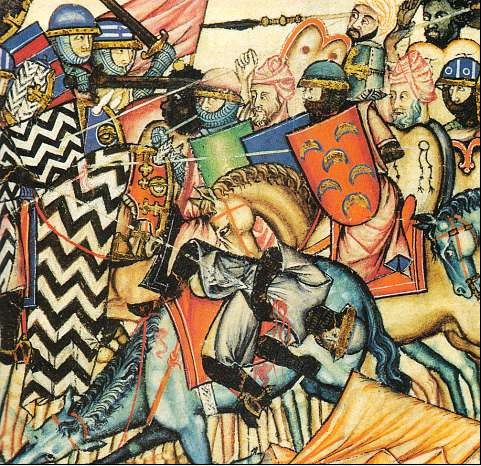 A battle of the Reconquista from the Cantigas de Santa Maria Medieval Spain was the scene of almost constant warfare between Muslims and Christians. The Taifa kingdoms lost ground to the Christian realms in the north. After the loss of Toledo in 1085, the Muslim rulers reluctantly invited the Almoravids, who invaded Al-Andalus from North Africa and established an empire. In the 12th century the Almoravid empire broke up again, only to be taken over by the Almohad invasion, who were defeated by an alliance of the Christian kingdoms in the decisive Battle of Las Navas de Tolosa in 1212. By 1250, nearly all of Hispania was back under Christian rule with the exception of the Muslim kingdom of Granada. |
イスラム教徒とキリスト教徒の戦い カンティガス・デ・サンタ・マリアによるレコンキスタの戦い 中世のスペインでは、イスラム教徒とキリスト教徒の戦いがほぼ絶え間なく続いた。 タイファ王国は北のキリスト教王国に領土を奪われた。1085年にトレドを失った後、イスラム教徒の支配者はしぶしぶアルモラヴィドを招き、彼らは北アフ リカからアル・アンダルスに侵攻し、帝国を樹立した。12世紀には、アルモラヴィド帝国は再び分裂し、アルモハドの侵略によって占領されたが、アルモハド は1212年のラス・ナバス・デ・トロサの戦いでキリスト教諸国の同盟軍に敗れた。1250年までに、イスパニアのほぼ全域がキリスト教の支配下に戻り、 イスラム教のグラナダ王国だけが残った。 |
Spanish language and universities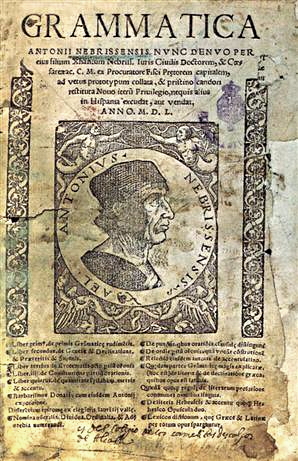 The title page of the Gramática de la lengua castellana (1492), the first grammar of a modern European language to be published. In the 13th century, many languages were spoken in the Christian kingdoms of Hispania. These were the Latin-based Romance languages of Castilian, Aragonese, Catalan, Galician, Aranese, Asturian, Leonese, and Portuguese, and the ancient language isolate of Basque. Throughout the century, Castilian (what is also known today as Spanish) gained a growing prominence in the Kingdom of Castile as the language of culture and communication, at the expense of Leonese and of other close dialects. One example of this is the oldest preserved Castilian epic poem, Cantar de Mio Cid, written about the military leader El Cid. In the last years of the reign of Ferdinand III of Castile, Castilian began to be used for certain types of documents, and it was during the reign of Alfonso X that it became the official language. Henceforth all public documents were written in Castilian. At the same time, Catalan and Galician became the standard languages in their respective territories, developing important literary traditions and being the normal languages in which public and private documents were issued: Galician from the 13th to the 16th century in Galicia and nearby regions of Asturias and Leon,[71] and Catalan from the 12th to the 18th century in Catalonia, the Balearic Islands and Valencia, where it was known as Valencian. Both languages were later substituted in its official status by Castilian Spanish, till the 20th century. In the 13th century many universities were founded in León and in Castile. Some, such as the Leonese Salamanca and the Castilian Palencia, were among the earliest universities in Europe. In 1492, under the Catholic Monarchs, the first edition of the Grammar of the Castilian Language by Antonio de Nebrija was published. |
スペイン語と大学 1492年に出版された『カスティーリャ語文法』の表紙。これは、ヨーロッパの近代的な言語の文法として初めて出版されたもの。 13世紀には、キリスト教国であったイスパニアでは多くの言語が話されていた。これらは、ラテン語を基盤とするロマンス諸語であるカスティーリャ語、アラ ゴン語、カタルーニャ語、ガリシア語、アラネス語、アストゥリアス語、レオン語、ポルトガル語、および孤立した古代言語であるバスク語であった。13世紀 を通じて、カスティーリャ語(今日ではスペイン語として知られている)は、カスティーリャ王国において、レオン語やその他の近隣の方言を駆逐して、文化や コミュニケーションの言語としてますます重要性を増していった。 その一例として、軍事指導者であるエル・シドを題材とした、現存する最古のカスティーリャ語叙事詩『エル・シドの歌』がある。カスティーリャ王フェルナン ド3世の治世の末期には、特定の種類の文書にカスティーリャ語が使用され始め、アルフォンソ10世の治世下でカスティーリャ語が公式言語となった。それ以 降、すべての公文書はカスティーリャ語で書かれるようになった。 同時に、カタルーニャ語とガリシア語はそれぞれの地域で標準語となり、重要な文学的伝統を発展させ、公的文書や私的文書が発行される際の標準言語となっ た。ガリシア語は13世紀から16世紀にかけてガリシア地方および近隣のアストゥリアス地方やレオン地方で、[71] カタルーニャ語は12世紀から18世紀にかけてカタルーニャ地方、バレアレス諸島、バレンシア地方で使用され、バレンシア語として知られていた。両言語は その後、20世紀までカスティーリャ語スペイン語に公式言語としての地位を奪われた。 13世紀にはレオンとカスティーリャに多くの大学が設立された。レオン語のサラマンカやカスティーリャ語のパレンシアなど、いくつかの大学はヨーロッパで 最も古い大学のひとつであった。 1492年には、カトリック両王の治世下で、アントニオ・デ・ネブリハ著『カスティーリャ語文法』の初版が出版された。 |
| https://en.wikipedia.org/wiki/History_of_Spain |
続きは、「スペイン初期現代期からブルボン期以前まで」 |
| Early modern Spain |
ス
ペイン初期近代 |
| Spain under the Bourbons,
1715–1808 |
ブルボン王朝時代のスペイン |
| From War of Spanish Independence
to First Spanish Republic 1808–1874 |
スペイン独立戦争から第一共和制の時代まで |
| Spain from 1868 |
1868
年以降の現代スペイン |
リ ンク
文 献
そ の他の情報
Copyleft, CC, Mitzub'ixi Quq Chi'j, 1996-2099
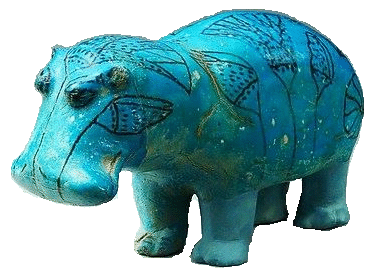
☆
 ☆
☆